Shattered smiles: Florida kids face dental crisis
Maggie Clark’s reporting on Florida’s Medicaid program for children was undertaken as a project for the Dennis A. Hunt Fund for Health Journalism, a program of the University of Southern California Center for Health Journalism.
Other stories in the series include:
Medicaid in Florida: 2 million kids. $24 billion battle.
Fighting for care in Florida's Medicaid system
An impossible choice: Doctors torn between patients and Florida's Medicaid system
2 Million Kids' series spurs support and quest for more data
Medicaid settlement: Florida will work harder to ensure health care for children
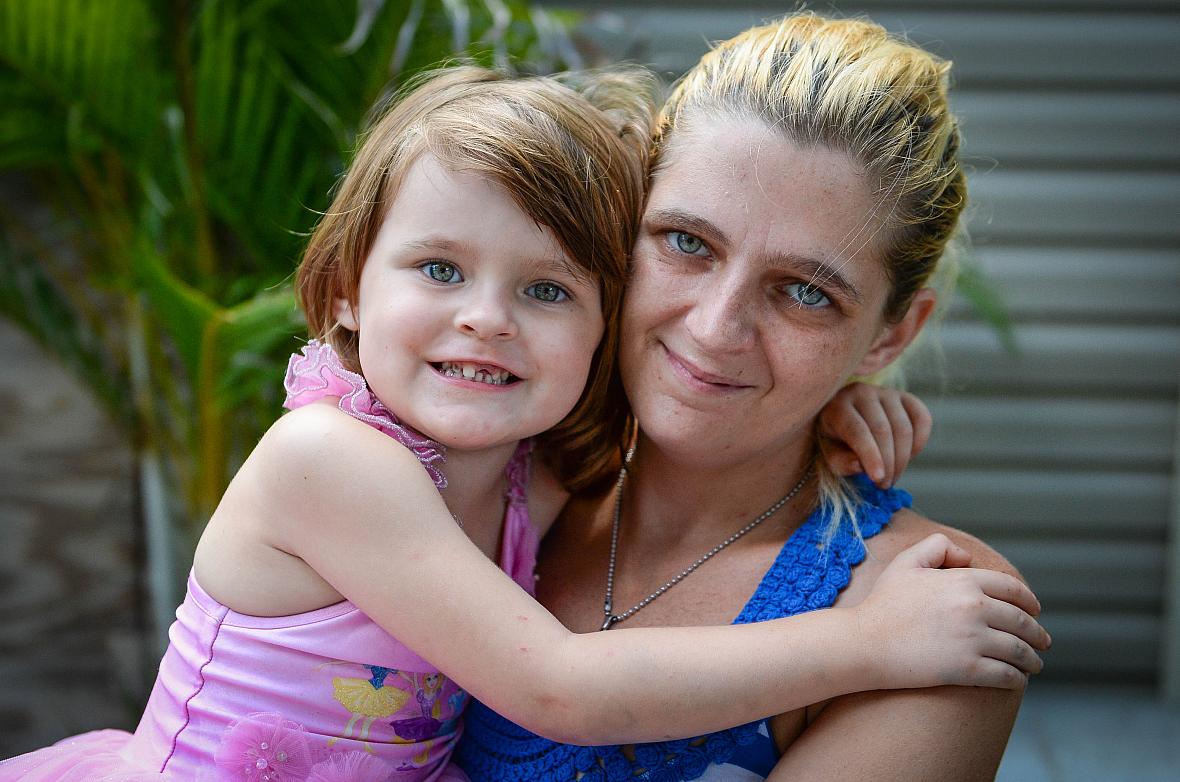
Keriana Carll, 4, and Megan Johnson pose in their yard in Bradenton. Johnson searched for months to find a dentist who was willing to accept Keriana's Medicaid insurance. Staff Photo/Rachel S. O'Hara
Keriana Carll cries in pain nearly every day. Her mouth hurts. She doesn’t eat much. The Bradenton 4-year-old who loves to blow bubbles has such severe dental disease that she had to get her front tooth pulled.
No dentist in Sarasota or Manatee County was willing to treat her. The only dentist her publicly funded Medicaid insurance company found who was willing to help the child is 50 miles north, in central Tampa.
Because she lives in Florida, Keriana is less likely to get access to preventive dental care and treatment than if she’d been born in any other U.S. state other than Wisconsin. On any given day in Florida, two out of three Medicaid-enrolled kids who need dental care do not receive it. In 2015, 1.5 million kids, or one-third of the state’s total population 19 and under, did not see a dentist that year.
Those aren’t the only numbers that paint a disturbing picture of a key component of health care for children under the joint federal and state Medicaid program for low-income Americans:
■ Florida ranked 50 out of 51 states and the District of Columbia in the percentage of Medicaid-enrolled kids getting preventive dental care; just 27 percent of kids got preventive dental care in 2014. Only one in 10 children — again, the state ranked 50 out of 51 — received any dental treatment that year, according to the U.S. Department of Health and Human Services.
■ Florida Medicaid reimbursed dentists just 37 percent of the standard rate for private insurance for services in 2013, the eighth-lowest rate in the nation, according to a report from the American Dental Association. Among dentists, low reimbursement rates were the top reason cited for refusing to see Medicaid patients, according to a dental workforce survey conducted by the Florida Department of Health.
■ Since 2000, the percentage of Florida children receiving any dental services has remained well below the national average, federal and state data show. Just 25.5 percent of children received any dental services in 2000. By 2015, the number had increased to 36.4 percent, despite the fact that the state has undergone a significant transition to a managed care system touted as a way to improve care and cut costs. Nationally, the percentage of children receiving dental services was 49 percent in 2015.
■ Florida’s spending on emergency room care for dental problems increased nearly five-fold between 2005 to 2014, according to a recent study from the University of Florida. Nearly 40 percent of the $234 million in hospital charges in 2014 was billed to the Medicaid program.
■ Efforts to encourage dentists to practice in underserved Florida communities have been routinely killed in the state Legislature or vetoed by the governor, including an effort this year.
While rates of dental care access for children nationwide have increased in recent years, Florida kids continue to go without. And though many consider a cavity just a childhood rite of passage, poor oral health can have lifelong consequences.
Low-income children are at especially high risk for dental cavities. Bacteria that cause cavities can spread through contact with saliva, often from parents to baby. A mother with poor oral health can transmit the bacteria to the fetus in the womb. The disease is exacerbated in young children by prolonged exposure to sugar, such as sleeping with a bottle or regularly drinking high-sugar fruit juices.
Though the decayed baby teeth eventually fall out, damage to the gums and other parts of the mouth continues as children grow adult teeth.
The social effects of dental disease can be as devastating as the physical ones. Florida adults with dental problems have difficulty interviewing for jobs, are plagued by social anxiety and report a lower quality of life than their peers with better oral health, according to a recent survey of Floridians conducted by the American Dental Association Health Policy Institute. Dental disease has been linked to heart disease, stroke, diabetes, pneumonia, poor pregnancy outcomes and dementia.
The state has reached a pivotal moment in addressing the problem: After 10 years of contentious litigation, Florida’s Medicaid agencies recently reached a settlement with pediatricians, pediatric dentists and parents, and pledged to a federal court they would work to improve health care, including dental care, for the millions of children who rely on the system.
But for the children needing care the situation is dire, said Dr. Jolene Paramore, a pediatric dentist in Panama City and the second vice president of the Florida Dental Association.
“This is a crisis,” Paramore said. “Is it OK that on a good day, just one-third of Medicaid-enrolled children get care? Is that acceptable? If that’s OK, then we’re not in crisis, but to me that is not OK.”
Keriana has yet to attend kindergarten, but she’s already had 10 cavities and has to visit specialists to get her teeth pulled.
Though her tooth decay has been visible for years, Keriana’s pediatrician never offered to apply fluoride to her teeth, said Keriana’s mother, Megan Johnson. Fluoride varnish is a proven preventive dental treatment that physicians can offer their patients and that Medicaid will reimburse.
Keriana Carll, 4, recently had her front tooth pulled. Her mother, Megan Johnson, searched for months to find a dentist who was willing to accept Keriana’s Medicaid insurance. Staff Photo/Rachel S. O'Hara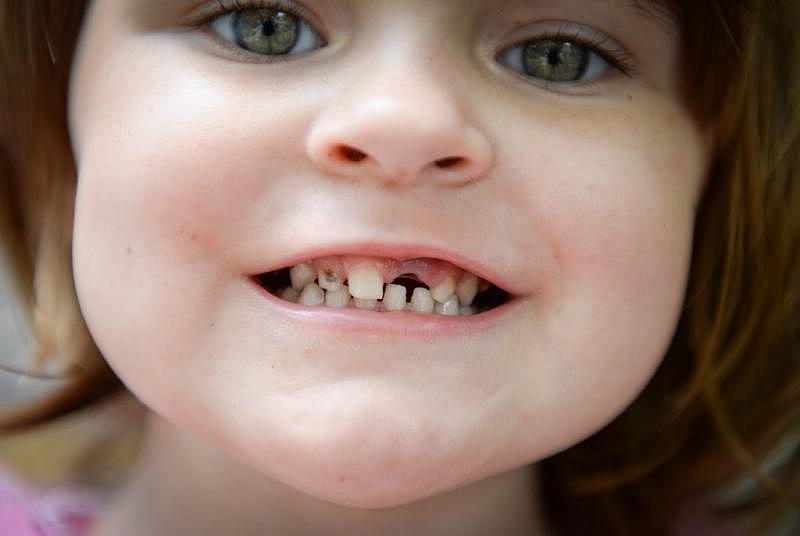
Johnson gets frustrated when talking about her struggle to find providers willing to help her daughter.
“It’s heartbreaking to watch our children going through this when they shouldn’t have to,” Johnson said.
“Dental pain is the worst pain — I’ve felt it myself. I’ve got pretty bad teeth and I know what’s she’s going through.”
Johnson knows that if she had private insurance or could pay cash, she’d have an easier time getting care for Keriana.
Among Florida children with private insurance, 61 percent had a dental visit in 2013, according to a report from the American Dental Association Health Policy Institute.
For Medicaid-enrolled children in Florida, just 30 percent saw a dentist that year, the report shows.
Finding a dentist willing to see Medicaid-enrolled children is a high hurdle. Because Florida’s Medicaid program relies on private insurance companies to create networks of dentists willing to take their members, parents rely on the health plans to give them accurate provider lists.
However, a survey conducted by the Herald-Tribune of dentists listed within 35 miles of the newspaper’s downtown Sarasota office found few dentists listed by the health plans actually participated in Medicaid.
To see the results of the survey and interact with the findings, visit this page.
The 35-mile radius is the allowable distance of a dentist from a patient’s home in an urban county, according to rules set by the Florida Agency for Healthcare Administration, which is responsible for regulating the Medicaid health plans.
The survey of all 103 dentists found that just two listings were fully accurate. The phone survey was conducted in March and April of this year.
Many dental offices did not know they were named on the health plan provider lists. Others had stopped accepting the insurance months ago, and did not realize they were still listed as participating providers.
AHCA is responsible for making sure the health plans have at least one dentist per 1,500 Medicaid-enrolled children in each county, as set out in the agency’s contracts with health plans.
Based on the Herald-Tribune survey, three of the four plans — Molina, Sunshine and Prestige — had no dentists with accurate listings willing to see patients in the Medicaid program within 35 miles of downtown Sarasota. The fourth plan, Liberty Dental, had two. The four health plans were responsible for contracting with dentists to care for more than 20,000 Medicaid-enrolled children in Sarasota County.
The agency has a scant record of enforcing company accuracy.
Only one managed care company, Humana, was fined $2,500 for failing to provide an adequate network of dentists to its members, said AHCA spokeswoman Mallory McManus.
Nationwide, inaccurate provider lists are a source of frustration for patients in private insurance and in Medicaid. A recent study of California public and private insurance directories published in the journal Health Affairs found that in less than 30 percent of the primary care physicians offices called were patients able to schedule an appointment, and the information listed in the provider directors was often inaccurate.
The difficulty that parents experience in finding providers is the opposite of the experience the program should provide, said Dr. Scott Tomar, chairman of the Department of Community Dentistry and Behavioral Science at the University of Florida College of Dentistry.
“For Medicaid-enrolled kids, dental care is an entitlement in federal law,” Tomar said. “The current system is neither adequately funded or user friendly. It seems like it was designed to create as many barriers to utilization for parents, kids and dentists, as possible.”
Though adequate dental care has been guaranteed by the Medicaid program in federal law since 1972, the reality of accessing dental care in Florida is much less secure, especially in rural or urban poor communities.
Florida’s rates of dental care access were low in the early 2000s, but so were those across the country. In 2000, 25.5 percent of Florida children enrolled in Medicaid saw a dentist, just under the national average of 29.2 percent of all children.
Fifteen years later Florida lags well behind the rest of the country. In 2015, the national average had nearly doubled to 49 percent of all Medicaid-enrolled children receiving some dental care. In states such as Connecticut and Texas, nearly 60 percent of children receive dental care.
Experts point to Florida’s low reimbursement rates for dentists as a key reason for the disparity.
Dr. Barry Setzer, who has operated a dental practice in Jacksonville for nearly 40 years, says that when he first opened in the 1970s, the Medicaid fee schedule was equivalent to about 65 percent of what he could earn by seeing an insured or cash-paying patient. Back then, he said, most area dentists accepted Medicaid.
But reimbursement rates did not keep pace with rising health care costs. In 2008, dentists received $15 for an oral exam, according to an AHCA legislative budget document from 2008. Those rates were lower than those in Georgia, North Carolina, Tennessee and West Virginia, the agency noted. They’d been unchanged for more than 20 years.
Even though the state raised reimbursement rates by 48 percent in 2011, they are still little more than one-third of what dentists earn for seeing a privately insured or cash-paying patient.
Additionally, the program’s administrative complexity has soured dentists on participating.
Already struggling to attract dentists, in late 2005, the dental program underwent a fundamental change. At the urging of then-Gov. Jeb Bush, Florida lawmakers began to overhaul the entire Medicaid program and contracted much of its management to private insurance companies.
Instead of the state paying dentists and other health providers directly, private insurance companies became responsible for creating networks of health providers and paying rates negotiated between the companies and the providers.
The extra layer of bureaucracy has been “a curse,” said Sen. Alan Hays, R-Umatilla, who is retiring this year after 10 years in the Florida Legislature and has been a practicing dentist for 40 years.
Dentist and State Senator Alan Hays, left, examines patient Sean Washington on the Florida Baptist Convention’s Mobile Dental Unit at the Central Florida Hampton Center car lot Wednesday morning, June 27, 2012. (Doug Engle/Ocala Star-Banner)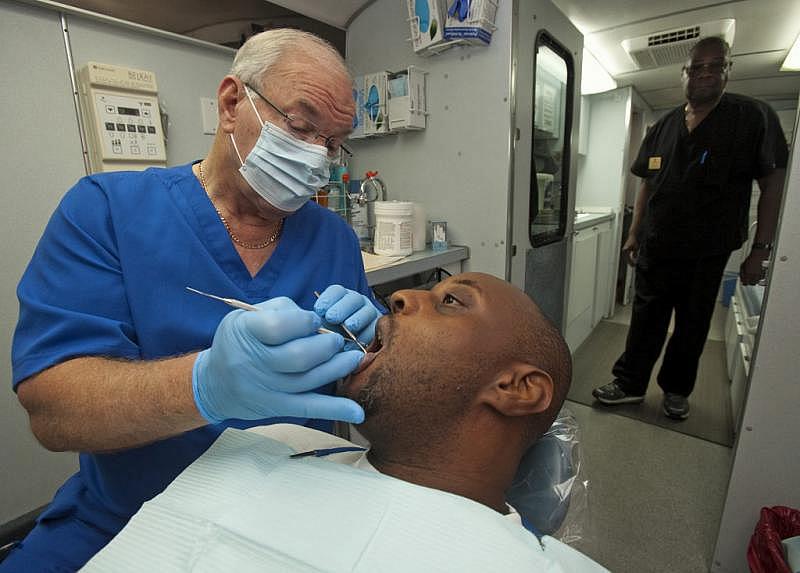
“These patients are the ones that are the least privileged and they have the weakest voice in the Legislature, and then you have the managed care companies that are moving checks through lobbyists to support candidates and telling them, ‘We’re giving you this check to protect us and the managed care program,’” Hays said.
“Through managed care, the Legislature has been successful at diverting patient care dollars to support a whole new industry of administrative costs and salaries, on the backs of the taxpayers. The bureaucracy has created so many challenges for the dentist and the patients,” Hays said.
Currently, about 18 percent of Florida dentists, or 1,544 in total, participate in the Medicaid program, according to the 2013-14 survey of the dental workforce conducted by the Florida Department of Health.
The baseline number of dentists needed to meet the requirements of the Medicaid managed care program — one dentist per every 1,500 Medicaid-enrolled children — was 1,499 dentists in 2014.
Those dentists may not be serving new Medicaid patients, however. There is no requirement that providers accept new patients or see a minimum number of patients to be counted as a participating provider, AHCA spokeswoman McManus said in a statement.
§
The statewide transition to managed care also made it harder for dentists to know which companies were in charge of their patients’ care. Dental care is managed by medical health plans, and is not a separate part of the state Medicaid budget.
The lack of transparency is troubling to Paramore, the Panama City dentist.
“For all we know, the dental plans are spending just 15 percent on care and 85 percent on administrative expenses,” Paramore said. “There’s no incentive for the dental plans to spend anything on care and treatment.”
Dental spending was not always a black box. Before 2005, when the Medicaid program began its transition to a managed care system, program administrators knew exactly how much they spent on dental care, and every other health service.
But in county and statewide managed care pilot programs, the state experimented with providing dental care through medical plans, which subcontracted with dental plans not directly accountable to state regulators.
When the program expanded statewide in 2014, lawmakers chose the subcontractor model for dental care. These subcontracted dental plans have no medical loss ratio, meaning there is no requirement that dental plans spend a higher percentage on care than on administration.
There is no way to know exactly how much money in the $24 billion Medicaid program the medical insurance companies allocate to dental care.
“Plans do not report administrative costs specific to each type of service covered,” McManus said. “There is no medical loss ratio specific to specific services, and dental is no exception. Overall, (medical) plans on average have a medical loss ratio of roughly 90 to 92 percent on covered services, including medical, pharmacy, behavioral health and dental.”
In the legislative session earlier this year, after the lobbying efforts of dental insurance companies, Gov. Rick Scott signed a bill to conduct a study that could trigger a shift back to carving out dental services from medical plans beginning in 2019. The change could make the dental plans accountable to the state and require them to comply with a medical loss ratio.
Sen. Don Gaetz, R-Niceville, speaks during a ceremony at the Florida Capitol Monday Sept. 19, 2011, in Tallahassee, Fla. (AP Photo/Phil Sears)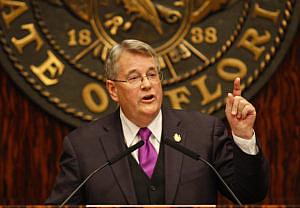
If it happens, it will be the fourth large-scale administrative change for Medicaid dental care since 2005.
The flip-flopping of systems does nothing to address the underlying problems in the Medicaid program, said Sen. Don Gaetz, R-Niceville, former Senate president and health care executive.
“At the end of the day, no matter what study someone does, you wind up with people who can’t get to the dentist, and even if they can get there, the dentist either can’t afford to see them under the current reimbursement structure, or people can’t afford to pay for the basic services they need,” Gaetz said.
“A lot of people are caught in the system and the dentists, who are well meaning, can’t afford to essentially pay to provide the care.”
§
In that vacuum, dentists are turning to volunteer care. More than three times the number of dentists who participated in Medicaid reported that they’d volunteered for at least an hour in the last two years, the workforce survey showed.
They’re attempting to fill a huge need. Recent free dental events in Bradenton and Jacksonville drew thousands of needy adults and children who waited overnight in their cars for care.
Last November in Bradenton, a two-day free clinic treated 1,128 people, most seeking dental care.
At the Jacksonville event in April, sponsored by the Florida Dental Association, volunteers treated 2,930 patients, but had to turn away another 6,500 people who showed up.
The increasing reliance on volunteer care, Tomar said, is a symptom of a dysfunctional Medicaid dental system.
“I think the dentists are offering this care from the goodness of their heart, but this is not public health,” Tomar said.
“It’s a feel-good thing for that day but it’s not a system that provides access to ongoing care. It doesn’t address the ongoing factors that make people willing to sleep on the sidewalk to get any dental care.”
Florida Dental Association leaders acknowledge that volunteer care is not the solution to the Medicaid program’s dysfunction, but while the dental association continues to advocate for systemic change, the volunteer care is better than nothing.
The association does not advocate for its members to participate in the Medicaid program. The administrative burdens are just too cumbersome and the reimbursement rates are too low to make it a policy to endorse, said Joe Anne Hart, the association’s lobbyist.
§
In June, a federal judge approved a settlement in a decade-long lawsuit between Florida’s Medicaid agencies and parents, pediatricians and pediatric dentists. The state has pledged to work with health providers to improve the program, which the court had found previously violated enrolled children’s rights to adequate health care. Though the settlement gives the state five years just to meet the 2014 national averages for care, the settlement is a major opportunity for change in the program.
“Florida has taken the first step to improving quality in Medicaid by measuring and reporting on key quality indicators, like the number of children receiving a preventive dental visit annually,” said Kelly Whitener, associate professor at the Georgetown University Center for Children and Families. “But, Florida’s data reflects that there is significant room for improvement. It would be our hope that by 2021, children in Florida would be receiving preventive dental services at a rate well above the 2014 national average.”
But until major changes happen, it’s likely that patients will continue to seek care in the place of last resort — hospital emergency departments.
Almost every night at Doctors Hospital in Sarasota, an adult, and sometimes a child, will visit the emergency room with a major dental problem — often a tooth infection that swells the face and can spread to other parts of the body.
A new trauma room at Doctors Hospital in Sarasota. (October 29, 2015; Staff Photo/Thomas Bender)
Unfortunately there’s not much the hospital’s ER team can do, said Marilee Arnold, director of emergency services at Doctors Hospital. Like in most emergency departments, there are no dentists on call. Providers can give pain medication and antibiotics, and share a list of dentists who might accept the patient, assuming the patient can call and get transportation to the appointment.
Statewide, the number of people seeking dental care in the ER is skyrocketing.
Nearly 60,000 more patients sought dental care in the ER in 2014 than in 2005, according to an analysis from the University of Florida. The 57 percent increase represents a major strain on hospitals, which are the final stopgap in a health system lacking in preventive dental care.
Overall, 163,906 people went to Florida’s emergency rooms for dental care in 2014, compared with 106,646 people in 2005, the UF analysis found.
The largest age-group of patients seeking dental care in the emergency department was adults age 25-34, but Florida emergency departments saw a 70 percent increase in the number of 5-14 year-olds seeking dental care in the ER, the researchers found.
Even larger was the cost increase, from $47.7 million for dental care in hospital ERs, to $234.4 million.
About 40 percent of those charges, or roughly $93 million in 2014, were billed to Medicaid. In a state that spends roughly $250 million on its Medicaid dental program overall, spending such a large sum on ER care shows the scale of Florida’s problem, said Tomar, one of the study’s authors.
“If people had real access to dental care, they wouldn’t be at the emergency department,” Tomar said. “In focus groups we’ve done with patients who use the emergency department for dental care, a majority of people say they know they’re not going to get definitive dental care in the emergency department. But they’re so desperate to get out of pain, they come anyway.”
§
Even in hospitals with dentists on call, such as Wolfson Children’s Hospital in Jacksonville, there’s still not much care available for Medicaid patients. The hospital’s pediatric dental program, established about 40 years ago, has trouble attracting dentists who will take Medicaid-enrolled kids as patients, said Dr. Barry Setzer, who serves as the hospital’s chief of pediatric dentistry.
While he and six other dentists are responsible for being on call for the emergency department, he is not contracted with any of the Medicaid managed care insurance companies. He primarily works with children with special needs who are served by the state’s Children’s Medical Services network.
“If a Medicaid patient comes through the pediatric emergency department, we will do the emergency care for free in my office rather than deal with getting credentialed by the Medicaid plans,” Setzer said. “But we can’t take these kids on as full-time patients. We try to connect them with a Medicaid provider as best we can.”
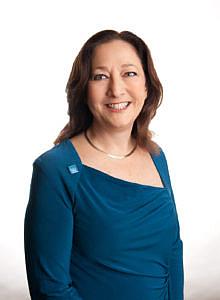
Like the children, many adults, with or without dental insurance, struggle to find any consistent care after their symptoms are treated in the emergency department. The emergency staff is not equipped to help with the underlying dental disease, which is often the result of years — maybe even a lifetime — without preventive dental care.
“There are some things that we’re able to fix when patients are here with us, like we can sew up a cut and we feel good because we fixed them,” Arnold said. “But there are a lot of times where patients come in with symptoms and we eliminate life-threatening possibilities, and then we just have to send to the dentist or specialist. It is frustrating when we can’t help the patients right away.”
In different pockets throughout the state, oral health coalitions are working on creating emergency room diversion programs for people needing regular dental care, and a few local efforts are underway to improve the system.
But the fact remains, every day, millions of Florida kids are going without needed dental care, which threatens their school performance and puts them at risk for a lifetime of dental pain and health problems.
“With good oral health, even if these kids don’t have a lot of other opportunities, they can at least have a smile that takes them out into the world, so they can be the best they can be,” Paramore said.
“If we’re not willing to invest in our kids, and they’re missing school and not learning, what does that say about us?”
[This story was originally published by the Herald-Tribune.]

